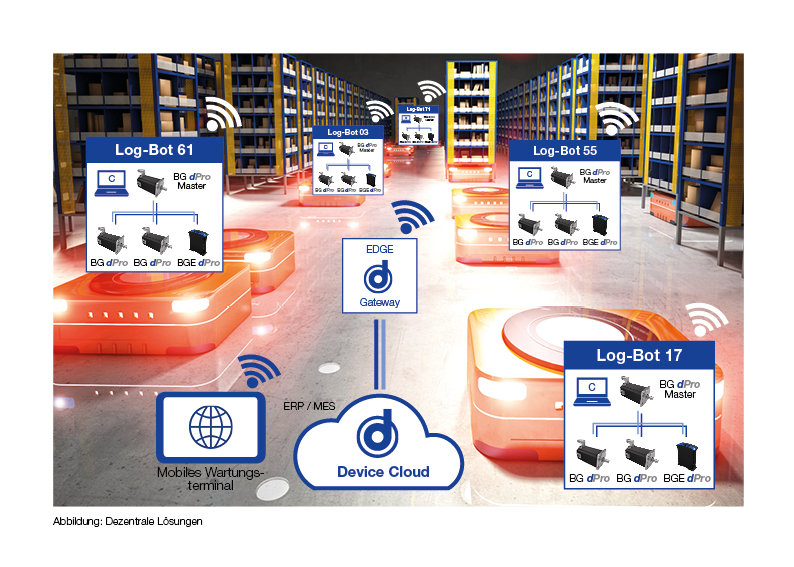www.automation-mag.com
17
'20
Written on Modified on
Dunkermotoren News
PROFESSIONAL ARTICLE: SMART, CONNECTED MOTORS ENABLE DECENTRALISED SOLUTIONS WITHOUT PLCS
Due to the influences of the "Internet of Things", more and more intelligence is being shifted from the control level to end devices. Process logic and analytics are moving further and further into higher levels up to the cloud.

This insidious diffusion of the control level opens up completely new approaches for decentralized control concepts. As the global market leader for integrated BLDC motors, Dunkermotoren has been a pioneer in decentralized intelligent motors for 20 years. Dunkermotoren provides its customers with innovative solutions for implementing new decentralised control concepts without PLCs.
Decentralized architectures follow the approach that decisions are made directly where the resulting actions are executed. Only higher-level logic such as process data acquisition, workpiece tracking or visualization is taken over by higher-level systems. In concrete terms, this means that all time-critical applications that must be executed in real time are executed directly on the field devices. All remaining applications that are not time-critical can also be taken over by management systems that are not real-time capable. The integrated smart motors of the BG series from Dunkermotoren have internalized this approach and provide the necessary tools for decentralized concepts due to their free programmability in C and networkability via common industrial communication systems. But what structural advantage does a decentralized architecture offer over a centralized architecture?
One of the two obvious advantages is the reduced wiring effort, as not all field devices have to be routed to a central control system. The second is the reduced space requirement, as no large central control cabinet is required. These two advantages, together with the savings for control elements that are no longer required, have a positive effect on cost and installation space optimization.
However, there are other significant advantages that are not obvious at first glance. On the one hand, modular modules for machines can be realized using a decentralized approach. Enclosed modules consisting of mechanics, electrics and software can be developed. The advantage of using software as an example is that parameters and settings do not have to be reassembled and reconfigured from complex master software code modules for each new project, but rather the ready-developed modules can simply be re-combined. The same applies to both the mechanical and electrical components. Development times and possible sources of error within projects can thus be drastically reduced, as can the costs for product maintenance of variants. The combination of a modular system allows an enormous variety of variants to be offered to customers. However, internal complexity is drastically reduced by the maintenance of simple, standardized and comprehensive modules.
Within a modular system, a module always performs a precisely defined partial task, e.g. unwinding a foil. All necessary motors are contained in the module and react independently to linked sensor signals or actions of other motors, which also belong to the module. If several identical tasks have to be carried out in one system, a module can be used several times without additional effort. If it is a similar but slightly modified application, a new module can easily be derived from an existing module. Modules can therefore be kept simple, keeping complexity and interactions within manageable limits. This also shows another advantage of a decentralized concept: The simple and high scalability.
Up to this point, decentralised approaches were already feasible in the past. Many Dunkermotoren customers have already implemented these in their applications and successfully established them on the market. As mentioned at the beginning, the influences of the "Internet of Things" are new. Their goal is to aggregate data into information in the field devices and transfer it directly to cloud systems for further processing. This means that even more intelligence is transferred to the field devices. Standards such as OPC UA, with or without TSN and MQTT, create a continuous communication line across all levels, directly from the field level to the management level. If one refers these developments back to the modular decentralized approach, this means that information that has to be exchanged within the modules or between modules and the HMI can be exchanged directly with TSN in real time via OPC UA. Information required for monitoring or process control is transferred directly to management systems or the cloud via MQTT or OPC UA. However, IT security also plays an important role when connecting to the "Internet of Things".
One approach is to create a single controllable access point to the system. This approach can be implemented with the help of IoT gateways, which also master the OPC UA and MQTT communication standards and also provide IT security in terms of hardware. The IoT gateway functions as a "single point of entry" between the individual modules and the "Internet of Things". This also does not contradict the decentralized approach, since an IoT gateway can also be accommodated decentralized due to its small design and only entails a fraction of the costs of a control system. Thus, the advantage of this development is obvious: A consistent communication architecture independent of rigid levels, combined with a much simpler implementation and maintenance. Information is transmitted directly from the point of origin to the point of use, without unnecessary detours. If this development is consistently pursued, the question inevitably arises: Will the PLC or the entire control level still be needed in the future? Dunkermotoren has recognized the potential of this development and is in the process of integrating OPC UA and MQTT into its smart motors in order to offer its customers these advantages.
In summary, the advantages of a decentralized control concept lie in cost and space savings, reduced overall complexity, high scalability and the possibility of an integrated, future-oriented communication architecture. With a broad portfolio of smart BLDC motors from the BG series and experience in implementing decentralised concepts, Dunkermotoren is your perfect partner to support you in implementing a decentralised control concept with know-how and market-leading products.
www.dunkermotoren.com

